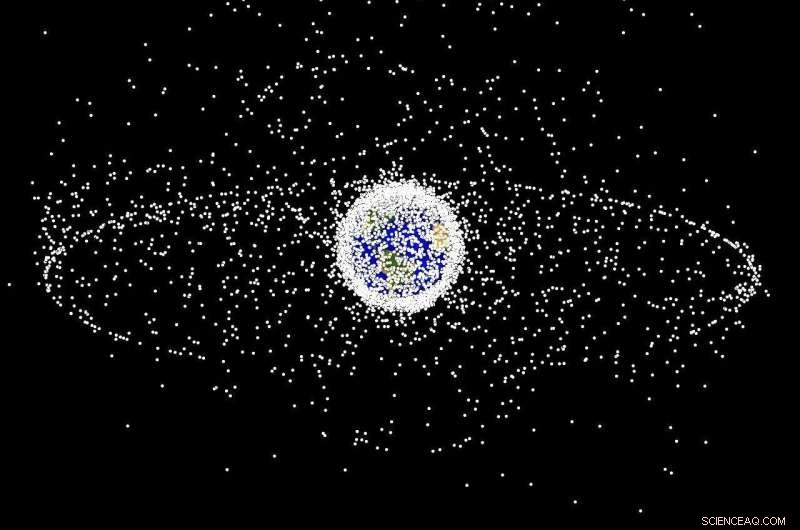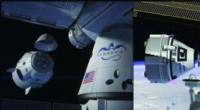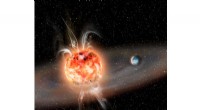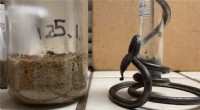Hvordan ville et bæredygtigt rummiljø se ud?

Kredit:Pixabay/CC0 Public Domain
Den 4. oktober 2022 bliver en lovende dag, da menneskeheden fejrer 65-året for begyndelsen af rumalderen. Det hele begyndte i 1957 med opsendelsen af den sovjetiske satellit Sputnik-1, den første kunstige satellit nogensinde sendt i kredsløb. Siden dengang er omkring 8.900 satellitter blevet opsendt fra mere end 40 lande verden over. Dette har ført til voksende bekymringer om rumaffald og den fare, det repræsenterer for fremtidige konstellationer, rumfartøjer og endda levesteder i lav kredsløb om jorden (LEO).
Dette har ført til mange foreslåede løsninger til at rydde op i "rumskrammel" såvel som satellitdesigns, der ville give dem mulighed for at deorbitere og brænde op. Ak, der er stadig spørgsmål om, hvorvidt en planet omgivet af mega-konstellationer er bæredygtig på lang sigt. En nylig undersøgelse af James A. Blake, en forsker ved University of Warwick, undersøgte udviklingen af affaldsmiljøet i LEO og vurderede, om fremtidige rumoperationer kan udføres bæredygtigt.
For sin ph.d. Projektet fokuserede Blake på billeddannelse og sporing af rumaffald i geosynkrone jordbaner (GEO'er) omkring 36.000 km (22.370 mi) over ækvator. I denne region af rummet følger satellitter Jordens rotation og har samme omløbsperiode som Jorden, hvilket gør den meget eftertragtet til telekommunikation. Men pladsen i denne region er meget begrænset, hvilket kan føre til alvorlige problemer med overbelægning og affald.
Især Blakes hovedværk var en undersøgelse af svagt geosynkront affald udført ved hjælp af Isaac Newton-teleskopet ved Roque de los Muchachos-observatoriet på øen La Palma. Hans arbejde blev opsummeret i en undersøgelse med titlen "DebrisWatch I:A survey of faint geosynchronous debris", som udkom i januar 2021 i tidsskriftet Advances in Space Research. Som han indikerede i denne undersøgelse, er populationen af affald i GEO ikke begrænset, men repræsenterer et voksende problem.
Et historisk problem
Ifølge ESA's Space Debris Office (SDO) er der pr. 3. marts 2022 blevet opsendt omkring 12.720 satellitter i kredsløb om Jorden siden Sputnik-1. Af disse forbliver anslået 7.810 i kredsløb, hvoraf omkring 5.200 stadig er i drift. Alt i alt spores omkring 29.860 affaldsobjekter i LEO regelmæssigt af jordbaserede observationsnetværk og vedligeholdes i deres katalog.
Tidligere troede man, at bestanden af affald i GEO ville være ret ubetydelig på grund af de strenge afstandsregler, der er beregnet til at sikre, at satellitter ikke kolliderer. However, the recent apparent destruction of communications satellites—AMC-9, owned by Luxembourg-based telecom SES S.A., and Lockheed Martin's Telkom-1—has provided clear evidence that a debris field exists in GEO. This presents new implications for future constellations in GEO.
As Blake told Universe Today via email, charting the evolution of space debris is essential to the future of debris mitigation:
"Sputnik 1 was the first of thousands of satellites to be launched into Earth orbit over the past six decades, and that number continues to grow rapidly. Some have re-entered the Earth's atmosphere, while others are orbiting in an abandoned and uncontrolled state, posing a threat to the active satellites we rely on.
"Over time, the orbital debris population has grown due to accidental explosions and collisions, alongside intentional anti-satellite tests. The vast majority of debris produced by these events remains invisible to us, too small to be detected by our current generation of surveillance networks, yet still holding the potential to severely damage spacecraft."
According to Blake, there's a lesson to be learned from humanity's exploitation of the near-Earth environment. In keeping with the interconnected nature of space exploration and life on Earth, this same lesson applies equally to humanity's activities on the ground. In short, humanity needs to act sustainably so that future generations can enjoy and benefit from the freedoms we've enjoyed since the dawn of the Space Age. To do this, says Blake, collision avoidance is a must:
"Effective collision avoidance requires timely and accurate information. As satellite and debris catalogs grow ever larger, surveillance networks are being tasked with monitoring more and more objects to provide sufficient warning to operators, who can then opt to maneuver their craft out of harm's way."
Monitoring and mitigating
The current strategy for preventing an uncontrollable debris environment in orbit involves a two-pronged approach:tracking and "passivating." The task of tracking satellites and debris is handled by several space agencies and government offices worldwide. For instance, the Joint Space Operation Center at Vanderburg Air Force Base in California (JSpOC) uses the Space Surveillance Networks (SSNs), a combination of optical and radar sensors, to monitor satellites and debris in orbit.
The NASA Orbital Debris Program Office (ODPO), located at the Johnson Space Center, measures the orbital debris environment while developing measures to control debris growth. The Office of Safety and Mission Assurance (OSMA), located at NASA HQ in Washington D.C., is responsible for developing, implementing, and overseeing agency-wide policies and procedures to ensure safety, reliability, and space environment sustainability.
There's also the ESA's Space Debris Office (SDO)—located at the European Space Operations Center (ESOC) in Darmstadt, Germany—which is responsible for measuring and modeling the orbital debris environment and developing protection and mitigation strategies. It also coordinates activities and research efforts with the ESA's constituent agencies, which form the European Network of Competences on Space Debris (SD NoC).
At the international level, there's the Inter-Agency Space Debris Coordination Committee (IADC), a forum that includes thirteen national space agencies (including NASA, Roscosmos, the ESA, and the Indian and Chinese space agencies). This body developed guidelines in 2001 that have been revised multiple times (the most recent occurring in 2020) and have since been adopted by the United Nations Committee on the Peaceful Uses of Outer Space (UNCOPUOS).
On the other end of things, there's the famous "25-year rule," where operators are encouraged to dispose of satellites within 25 years of mission completion via atmospheric re-entry. Low-altitude satellites may already be naturally capable of doing this. In contrast, potentially non-compliant satellites can be outfitted with thrusters, drag sails, and other instruments to accelerate the deorbiting process. As Blake explained:
"Operators are encouraged to 'passivate' spacecraft at the end of their mission, by depleting or saving any remnant sources of internal energy onboard the satellite or rocket body, thus reducing the chances of explosion. Adherence to the '25-year rule' for deorbiting spacecraft in low Earth orbit is still concerningly low, and a boost to cooperation on an international scale will be paramount to tackling the debris problem."
A problem of policy
In the end, Blake indicates that one of the greatest hurdles to achieving sustainability in space is policy. For the past few decades, the IADC guidelines adopted by UNCOUPOUS have formed the basis for standard mitigation practices on the international stage. Unfortunately, these guidelines are voluntary (i.e., not legally binding), and some space-faring nations have chosen not to include them in their national regulatory frameworks.
In addition, adherence to the "25-years rule" remains very low in LEO, and the process of re-entry is not a viable option for objects in the high-altitude GSO region. As a result, operators will typically attempt to raise decommissioned satellites into so-called "graveyard" orbits well beyond GSO—or what is known as a supersynchronous orbit (SSO). This has the effect of clearing the operational zone in orbit for use by future satellites, but the debris can still pose a threat to spacecraft destined for the Moon or deep-space.
What is needed, says Blake, is a policy of active debris removal (ADR) that works in tandem with stricter adherence to regulations for debris mitigation:
"Ultimately, we'll want to conduct regular removal missions to actively dispose of dead spacecraft and debris, though a number of technological hurdles are yet to be cleared. As evidenced by the recent Russian ASAT test back in November 2021, there is also a need for internationally recognized, legally binding regulations, to sanction against reckless behavior."
In addition, NASA, the ESA, the China National Space Agency (CNSA), and other space agencies are currently testing ADR systems. Concepts include Earth-based directed-energy arrays (lasers), spacecraft equipped with plasma beams, harpoons and nets, and magnetic space tugs. In recent years, says Blake, there have also been efforts to formulate a "space sustainability rating" that would incentivize operators to adhere to safe practices and debris mitigation. However, several questions remain unanswered.
For instance, with access to space becoming more widespread, how does a regulatory framework compare University-led CubeSat experiments to commercial constellations of satellites (a la Starlink)? Also, how will lawmakers attribute liability in the event of a collision involving uncontrolled debris? And what mechanisms will be in place to ensure a level playing field between emerging space agencies and those with a decades-long presence in space?
The debate around these questions and attempts to find solutions are actively unfolding around us right now. It has also led to the rise of non-profit organizations like the Space Court Foundation (SCF) the Space Generation Advisory Council (SGAC). There are also the time-honored efforts to formulate and crystallize policy by the Institute of Air &Space Law (IASL) at McGill University and the United Nations Office for Outer Space Affairs (UNOOSA).
As our presence in space continues to grow, we can expect some spirited debate, resolutions, and impressive innovations in the coming years. As always, the driving force behind these developments will be a basic matter of necessity. Humanity's future in space depends upon accessibility and safety, something that cannot happen with huge debris fields in orbit.
Sidste artikelSådan taler du med rumvæsner
Næste artikelEt solcelleanlæg i rummet? Hvordan det ville fungere, og de fordele det kunne give
 Varme artikler
Varme artikler
-
 NASA bestiller yderligere astronaut -taxiflyvninger fra Boeing og SpaceX til ISSBoeing og SpaceX kommercielle mandskabskøretøjer, der færger astronauter til den internationale rumstation (ISS) i dette kunstnerkoncept. Kredit:NASA I et betydeligt skridt mod at genoprette Ameri
NASA bestiller yderligere astronaut -taxiflyvninger fra Boeing og SpaceX til ISSBoeing og SpaceX kommercielle mandskabskøretøjer, der færger astronauter til den internationale rumstation (ISS) i dette kunstnerkoncept. Kredit:NASA I et betydeligt skridt mod at genoprette Ameri -
 Superflares er mindre skadelige for exoplaneter end tidligere antagetSmå stjerner blusser aktivt og udstøder partikler, der kan ændre og fordampe atmosfæren på planeter, der kredser om dem. Nye resultater tyder på, at store superblus har tendens til at forekomme på høj
Superflares er mindre skadelige for exoplaneter end tidligere antagetSmå stjerner blusser aktivt og udstøder partikler, der kan ændre og fordampe atmosfæren på planeter, der kredser om dem. Nye resultater tyder på, at store superblus har tendens til at forekomme på høj -
 Billede:Astronaut Matthias Maurer træner til EVAKredit:NASA ESA-astronaut Matthias Maurer praktiserer rumstationsreparationer i Neutral Buoyancy Lab ved NASAs Johnson Space Center i Houston, USA. Den gigantiske pool er over 12 meter dyb og har
Billede:Astronaut Matthias Maurer træner til EVAKredit:NASA ESA-astronaut Matthias Maurer praktiserer rumstationsreparationer i Neutral Buoyancy Lab ved NASAs Johnson Space Center i Houston, USA. Den gigantiske pool er over 12 meter dyb og har -
 NASA-forsker over månen med forskning i hjemmedyrket radiseTime-lapse video taget med og iPhone (søndag, 14. juni, 10.00 til torsdag, 18. juni, 8:45) viser radiser, der spirer på køkkenbordet i Max Colemans hjem i Pasadena. Handlingen begynder i beholderen ti
NASA-forsker over månen med forskning i hjemmedyrket radiseTime-lapse video taget med og iPhone (søndag, 14. juni, 10.00 til torsdag, 18. juni, 8:45) viser radiser, der spirer på køkkenbordet i Max Colemans hjem i Pasadena. Handlingen begynder i beholderen ti
- Næsten en tredjedel af Mobile Bay-moserne er forsvundet siden 1980'erne, undersøgelse finder
- NASA får en natvisning, ex-Tropical Cyclone Dineo
- Præcis deuteration ved hjælp af tungt vand
- Fossilfund trækker datoen for de tidligste sammensmeltede knogler i fugle tilbage med 40 millioner …
- Føderale regering:Ingen truede arter på listen for hvalros
- Forskere afslører bemærkelsesværdige hestesko


